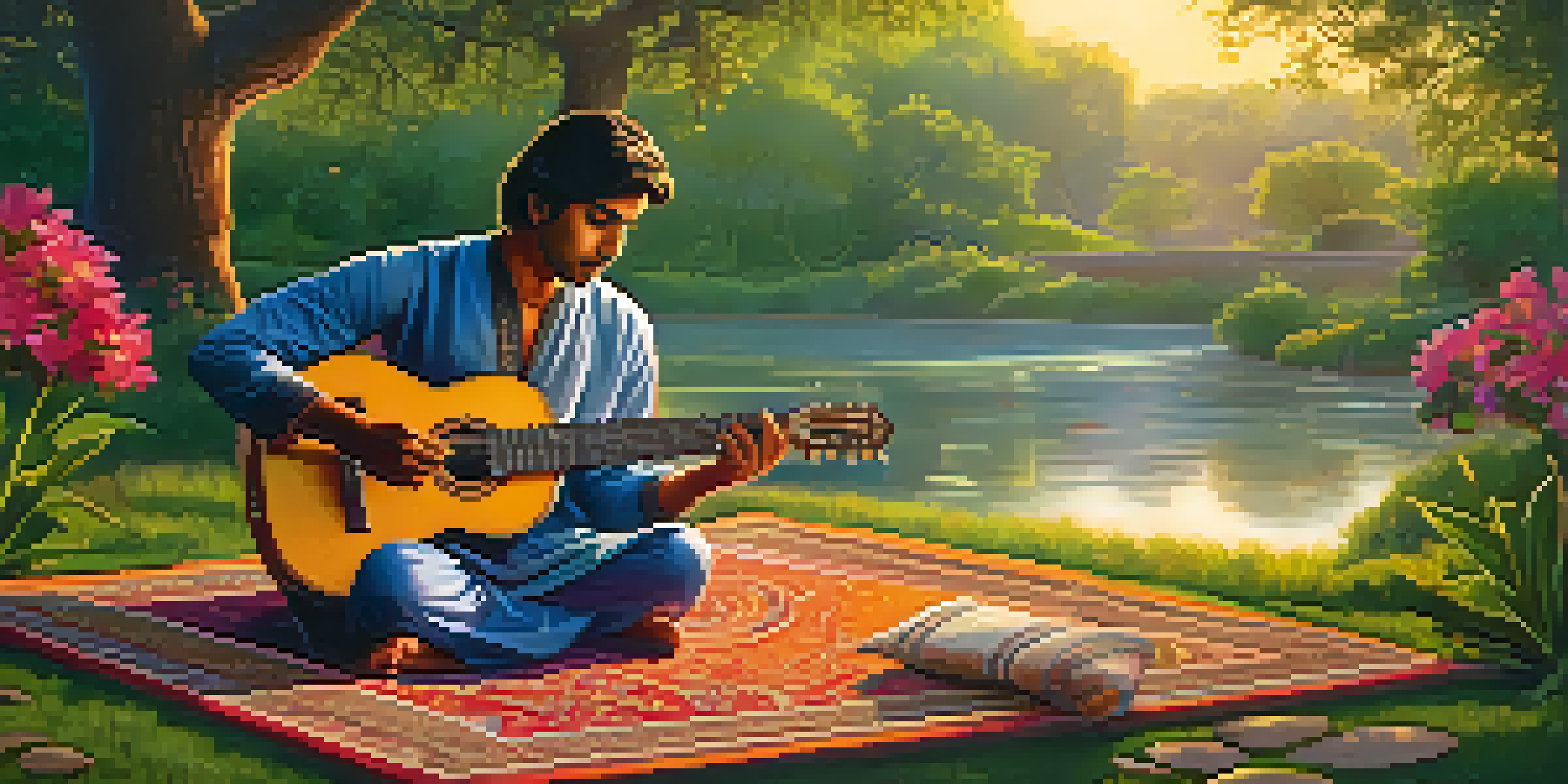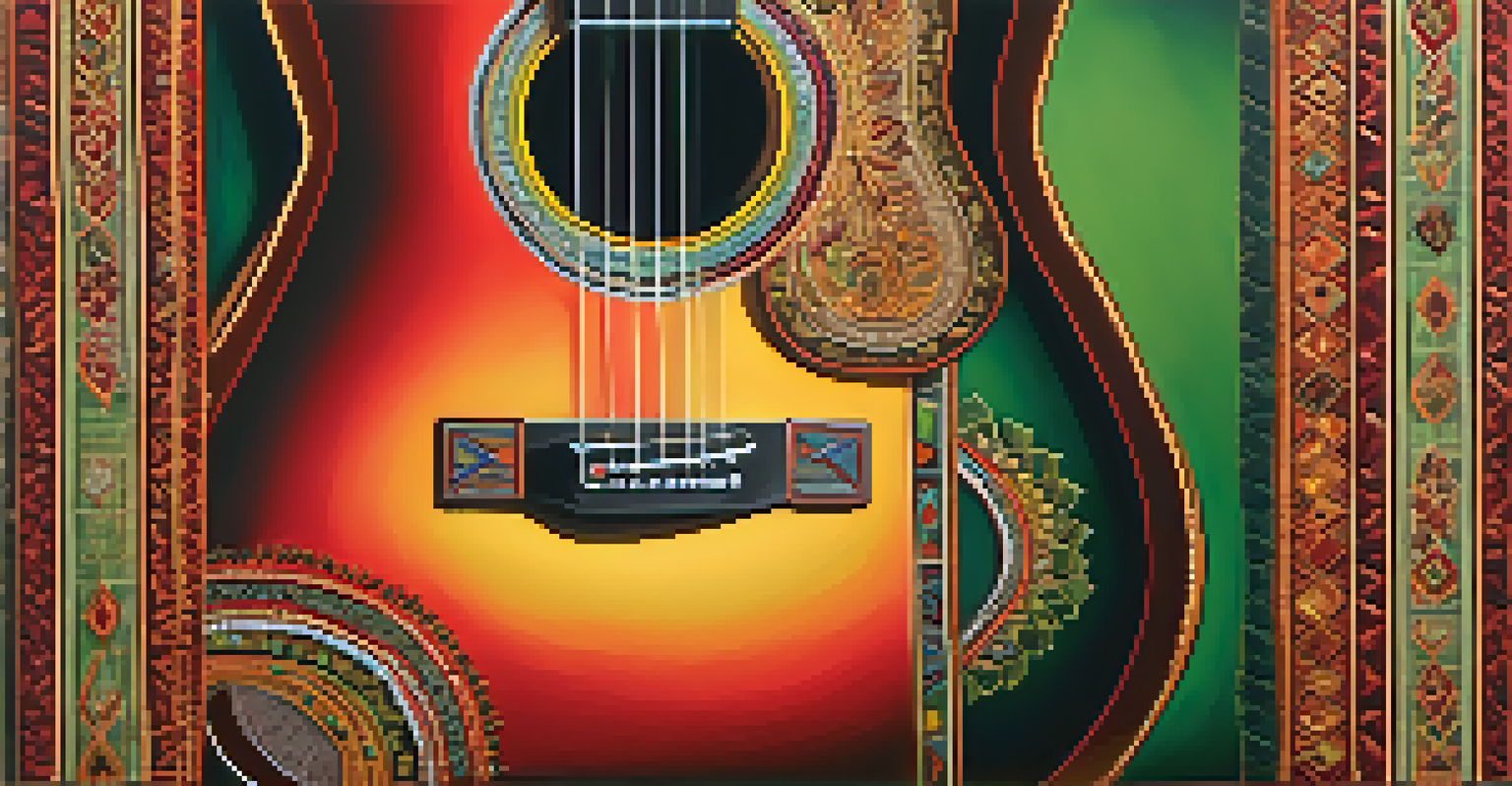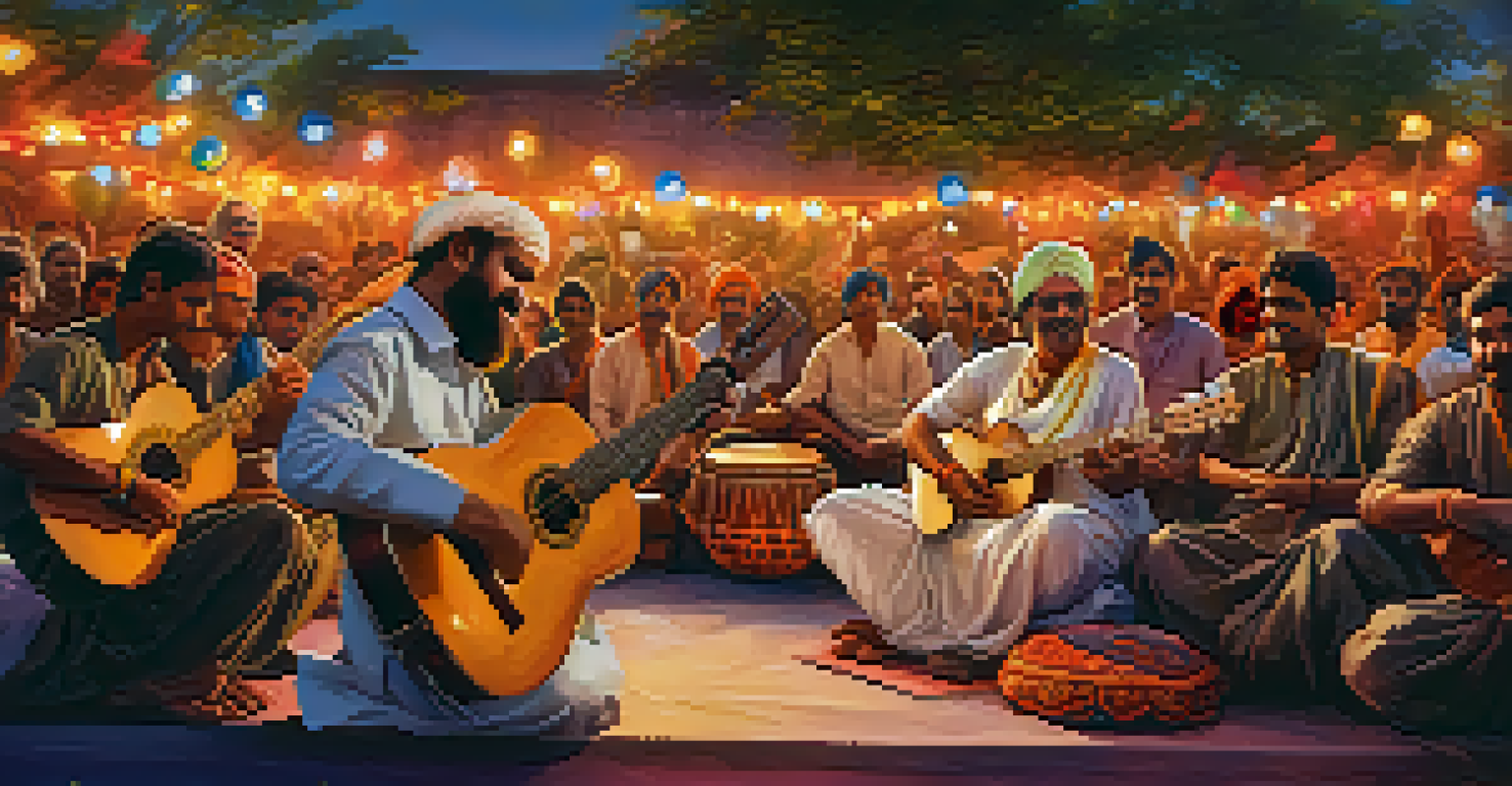Understanding Indian Classical Music's Impact on Guitar

The Roots of Indian Classical Music
Indian classical music has deep historical roots, tracing back thousands of years. This rich tradition encompasses two main forms: Hindustani and Carnatic, each with distinct characteristics. The intricate rhythms and melodic structures found in these styles have influenced musicians globally, including guitarists who seek to incorporate these elements into their playing.
Music can change the world because it can change people.
At its core, Indian classical music is based on ragas, which are specific melodic frameworks, and talas, which are rhythmic cycles. These components offer a wide range of emotional expression and improvisational freedom. Guitarists looking to expand their musical vocabulary can find inspiration in these traditional concepts, which allow for a unique fusion of styles.
Moreover, the spiritual aspect of Indian classical music, often intended for meditation and introspection, can add a new dimension to guitar playing. This connection to the emotional landscape can inspire guitarists to explore deeper feelings and connect with their audience on a more profound level.
Techniques Borrowed from Indian Styles
Guitarists can adopt various techniques from Indian classical music to enhance their playing. For instance, the use of slides, bends, and vibratos—common in Indian instrumental music—can create a more expressive sound on the guitar. These techniques mimic the nuances of vocal performances in Indian music, adding richness to the guitar's voice.

Additionally, learning to play in microtones, which are smaller intervals than the conventional semitones, provides a distinct flavor to the music. While Western music typically adheres to a 12-note system, Indian classical music's microtonal approach allows for a broader palette of sounds and emotions. Guitarists who embrace this can venture into uncharted territories of musical expression.
Indian Classical Music's Influence
Indian classical music, through its ragas and talas, enriches guitar playing with unique melodic and rhythmic elements.
Incorporating fingerpicking styles, derived from the sitar or veena, can also introduce unique rhythmic patterns and textures. By blending these techniques into their repertoire, guitarists not only diversify their skill set but also bring a fresh perspective to their compositions.
Ragas and Their Influence on Guitar Melodies
Ragas form the backbone of Indian classical music, and understanding them can significantly impact how guitarists craft their melodies. Each raga conveys a specific mood or emotion, and adapting these melodic frameworks can create captivating musical narratives. Guitarists can experiment with traditional ragas to evoke feelings that resonate with their audience.
The beautiful thing about learning is that no one can take it away from you.
When guitarists infuse ragas into their playing, they often explore improvisation—a key component of Indian classical music. This improvisational element not only enhances creativity but also allows for spontaneous musical conversations within a performance. By embracing this practice, guitarists can cultivate a dynamic and engaging stage presence.
Furthermore, the cyclical nature of ragas encourages endless exploration. Guitarists can reinterpret ragas in various styles, leading to innovative compositions that bridge cultural divides. This blending of traditions fosters a richer musical landscape, where the guitar becomes a medium for cross-cultural expression.
Rhythmic Complexity: The Tale of Talas
In Indian classical music, talas play a crucial role in defining rhythm. These intricate rhythmic cycles can range from simple patterns to complex structures, offering guitarists a wealth of options to explore. By understanding and integrating talas into their playing, guitarists can enhance their rhythmic awareness and bring a new dimension to their music.
For example, a common tala like Teentaal consists of 16 beats arranged in a specific pattern. Guitarists can adapt this cycle to create compelling rhythmic phrases, adding depth to their compositions. The challenge lies in mastering these patterns, which can lead to a more nuanced understanding of rhythm and timing.
Techniques Enhance Guitar Expression
Guitarists can adopt Indian techniques like microtones and slides to create more expressive and innovative sounds.
Incorporating talas into guitar playing not only enriches the music but also invites collaboration with percussionists. This fusion of guitar and traditional Indian instruments can lead to exciting performances that showcase the beauty of both worlds. The interplay between the guitar and rhythm creates a vibrant, engaging listening experience.
The Role of Improvisation in Indian Music and Guitar
Improvisation is a hallmark of Indian classical music, allowing musicians to express their individuality and creativity. For guitarists, this approach encourages spontaneous composition and exploration within a performance. By embracing improvisation, guitarists can tap into their intuition and develop a unique voice that resonates with listeners.
Learning to improvise within the structure of ragas and talas provides an exciting challenge for guitarists. It requires a deep understanding of the musical frameworks while allowing for personal interpretation. This duality fosters a sense of freedom and encourages guitarists to break away from rigid playing styles.
Moreover, improvisation creates a dialogue between musicians. When guitarists engage in improvisational exchanges with other instrumentalists, they cultivate a collaborative spirit that enhances the overall performance. This dynamic interaction can lead to unexpected musical moments, making each performance a memorable experience.
Cultural Exchange: Bridging Traditions Through Guitar
The fusion of Indian classical music and guitar exemplifies the beauty of cultural exchange. As musicians from different backgrounds come together, they share techniques, ideas, and inspirations that enrich their artistry. This blending of traditions can lead to innovative genres that resonate with diverse audiences.
Guitarists who explore Indian classical music often find themselves drawn to its unique characteristics, prompting them to incorporate elements into their compositions. This cross-pollination of styles not only broadens their musical horizons but also fosters a greater appreciation for the richness of different cultures.
Cultural Exchange in Music
The fusion of Indian classical music and guitar exemplifies cultural exchange, leading to innovative genres and performances.
Furthermore, collaborative projects between Indian musicians and guitarists can result in powerful performances that celebrate both traditions. These partnerships highlight the universality of music, demonstrating how it can transcend cultural barriers and connect people from all walks of life.
The Future of Guitar in Indian Classical Music
As the world of music continues to evolve, the future of guitar in Indian classical music looks promising. More guitarists are exploring this genre, blending traditional techniques with contemporary styles to create unique soundscapes. This evolution opens up new avenues for creativity and innovation within the musical landscape.
The rise of digital platforms has also made it easier for musicians to share their work and collaborate globally. Guitarists can now access resources that help them learn about Indian classical music, allowing for a wider dissemination of knowledge and techniques. This accessibility fosters a community of musicians eager to experiment and redefine boundaries.

Ultimately, the ongoing dialogue between Indian classical music and guitar will inspire future generations of musicians. As they continue to draw from this rich tradition, the guitar will undoubtedly carve out its own space within the realm of Indian classical music, creating a beautiful fusion that resonates with audiences around the world.